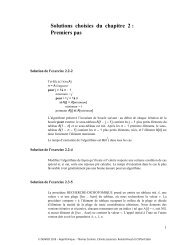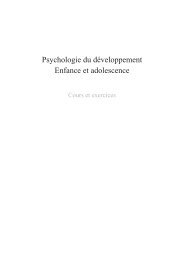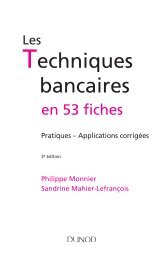- Page 1:
Corrigé des exercices 1
- Page 4 and 5:
4 P Q 9 10 11 12 13 14 15 16 V V F
- Page 6 and 7:
6 Dans tous les cas, un élément q
- Page 8 and 9:
8 2. f(A) = {1}; 3. f(A) = [0,2];
- Page 10 and 11:
10 l’hypothèse, g ◦f ne serait
- Page 12 and 13:
12 2. f est une bijection de R \ f
- Page 14 and 15:
14 Exercice 5.6 1. Considérons la
- Page 16 and 17:
16 3. En appliquant ce qui précèd
- Page 18 and 19:
18 façon que n = 4a+9b. Considéro
- Page 20 and 21:
20 D’autre part, (1 −a n )(1
- Page 22 and 23:
22 Chapitre 6 Exercice 6.1 Nous ne
- Page 24 and 25:
24 Exercice 6.8 1. Soit a un comple
- Page 26 and 27:
26 fait) que a ∈ [2 − √ 3,2+
- Page 28 and 29:
28 n−1 ∑ 2. Si ω p = 1, alors
- Page 30 and 31:
30 Exercice 6.27 On pose Z = z n .
- Page 32 and 33:
32 z 3 = 1 2 ⎛ ⎝− 1 − √ 5
- Page 34 and 35:
34 2. z 4 + 4z 3 + 4z 2 + 1 = z 2 (
- Page 36 and 37:
36 2. On calcule Q(1) = 0, puis, av
- Page 38 and 39:
38 Exercice 7.23 Si a est une racin
- Page 40 and 41:
40 Exercice 7.28 1. Posons Y = X +
- Page 42 and 43:
42 Exercice 8.4 La relation bien co
- Page 44 and 45:
44 • Pour n = 0, la propriété d
- Page 46 and 47:
46 Exercice 8.18 1. a) Pour tout en
- Page 48 and 49:
48 e) Chaque rangement de p boules
- Page 50 and 51:
50 3. Il faut ici d’abord réalis
- Page 52 and 53:
52 Soient f,g deux fonctions de A e
- Page 54 and 55:
54 Exercice 9.6 Soient a,b,c trois
- Page 56 and 57:
56 Exercice 9.10 1. Comme (−3,
- Page 58 and 59:
58 Exercice 9.14 Pour tout réel x
- Page 60 and 61:
60 Exercice 9.18 1. Si f était dé
- Page 62 and 63:
62 Exercice 9.24 1. Par définition
- Page 64 and 65:
64 6. Soient f,g ∈ E et λ,µ deu
- Page 66 and 67:
66 3. On sait que l’image par f d
- Page 68 and 69:
68 f est une application linéaire.
- Page 70 and 71:
70 Exercice 10.13 1. Montrons d’a
- Page 72 and 73:
72 2. a) Nous avons d’une part f(
- Page 74 and 75:
74 Exercice 11.3 Soit y ∈ Im(u+v)
- Page 76 and 77:
76 Or il est clair que Im(h) = Im(g
- Page 78 and 79:
78 Exercice 11.11 1. Tout d’abord
- Page 80 and 81:
80 Exercice 11.12 1. On a T(X) = (X
- Page 82 and 83:
82 Exercice 12.2 1. Soient A,B ∈
- Page 84 and 85:
84 De même (0,1) = a(1, −1)+b(2,
- Page 86 and 87:
86 4. Au rang 1, un endomorphisme n
- Page 88 and 89:
88 3. Avec les mêmes notations, on
- Page 90 and 91:
90 Exercice 12.14 1. L’image par
- Page 92 and 93:
92 4. On inverse la matrice de f da
- Page 94 and 95:
94 ⎛ → ⎜ ⎝ 2 −2 1 −5 3
- Page 96 and 97:
96 soit n−1 ∑ L n : x 1 + x n +
- Page 98 and 99:
98 En effectuant à nouveau les op
- Page 100 and 101:
100 2. Une équation de E −2 est
- Page 102 and 103:
102 3. λ est valeur propre si et s
- Page 104 and 105:
104 D’où E 0 = Vect(−1,0,1). U
- Page 106 and 107:
106 D’où E −1 = Vect(1,2,2). D
- Page 108 and 109:
108 1 er cas λ = −2 On obtient a
- Page 110 and 111:
110 Exercice 14.8 1. On triangule l
- Page 112 and 113:
112 4. a) On voit que ⎛ ⎝ c’e
- Page 114 and 115:
114 b) Avec une telle hypothèse su
- Page 116 and 117:
116 b) On a donc M = (a − c)PIP
- Page 118 and 119:
118 12. C’est vrai pour ⎛ n = 1
- Page 120 and 121:
120 18. On a donc ⎧⎛ ⎨ C(A) =
- Page 122 and 123:
122 Exercice 15.4 On a Si a > b, on
- Page 124 and 125:
124 Si (v n ) n∈N converge vers 0
- Page 126 and 127:
126 2. On a, pour n 1, lnu n = n
- Page 128 and 129:
128 En mettant en facteur √ 2, on
- Page 130 and 131:
130 2. On remarque que, pour tout n
- Page 132 and 133:
132 Exercice 15.23 1. On a, pour to
- Page 134 and 135:
134 Exercice 15.26 La suite (u n )
- Page 136 and 137:
136 On remarque que et on obtient (
- Page 138 and 139:
138 3. On déduit de la question 2
- Page 140 and 141:
140 x 1 1 1 . On a donc inf A et
- Page 142 and 143:
142 3. Notons p = Ent(nx) et effect
- Page 144 and 145:
144 5. En multipliant par l’expre
- Page 146 and 147:
146 Exercice 16.6 On note que, pour
- Page 148 and 149:
148 2. Soit x 0 ∈ R + et ε > 0.
- Page 150 and 151:
150 Exercice 16.15 1. On a, pour to
- Page 152 and 153:
152 2. Pour tout n ∈ N, u n − v
- Page 154 and 155:
154 On en déduit que u n √ k = e
- Page 156 and 157:
156 3. Pour n n 0 , on a v n+2 = |
- Page 158 and 159:
158 u 0 = 1 − 1 n , avec n ∈ N
- Page 160 and 161:
160 Si u 0 ∈ I 4 , la suite (u n
- Page 162 and 163:
162 Exercice 17.22 1. La fonction g
- Page 164 and 165:
164 b) La fonction f est décroissa
- Page 166 and 167:
166 et g(x) − x = (r + x2 ) 2 (1
- Page 168 and 169:
168 Exercice 17.29 1. La fonction g
- Page 170 and 171:
170 3. On étudie (x x ) x x xx De
- Page 172 and 173:
172 2. Puisque lim 2sin x = 1, on p
- Page 174 and 175:
174 Exercice 18.9 On compare la som
- Page 176 and 177:
176 On remarque que, pour tout enti
- Page 178 and 179:
178 On en déduit que nécessaireme
- Page 180 and 181:
180 3. Comme u n tend vers +∞, e
- Page 182 and 183:
182 4. On raisonne comme dans 3. En
- Page 184 and 185:
184 3. Pour n assez grand, on a nm
- Page 186 and 187:
186 Si g n’est pas strictement po
- Page 188 and 189:
188 On en déduit que lim |f(x)| =
- Page 190 and 191:
190 Pour tout y ∈] − 1,1[, y =
- Page 192 and 193:
192 5. On obtient : 0 arctan x < a
- Page 194 and 195:
194 2. La réciproque est fausse. S
- Page 196 and 197:
196 Pour le produit, on prend le lo
- Page 198 and 199:
198 Exercice 20.13 1. Si g(b) = g(a
- Page 200 and 201:
200 2. On procède comme dans la qu
- Page 202 and 203:
202 3. On a, pour tout réel x, f
- Page 204 and 205:
204 On obtient g ′ (x) = (c−x)(
- Page 206 and 207:
206 2. Soit f définie sur ] 0, π
- Page 208 and 209:
208 La fonction g α ′ s’annule
- Page 210 and 211:
210 Ainsi, si x < 0, f ′ (x) =
- Page 212 and 213:
212 n−2 ∑ Posons P n (x) = a k
- Page 214 and 215:
214 ce qui montre que la propriét
- Page 216 and 217:
216 ce qui est possible car x 0 n
- Page 218 and 219:
218 Exercice 20.43 1. La dérivée
- Page 220 and 221:
220 Chapitre 21 Exercice 21.1 1. On
- Page 222 and 223:
222 car e it ne peut pas être éga
- Page 224 and 225:
224 Ceci montre que la différence
- Page 226 and 227:
226 4. D’après la démonstration
- Page 228 and 229:
228 Exercice 21.13 La fonction f s
- Page 230 and 231:
230 4. Supposons que f tend vers +
- Page 232 and 233:
232 Exercice 21.18 1. Si M = 0, la
- Page 234 and 235:
234 Exercice 21.21 1. • Notons qu
- Page 236 and 237:
236 Comme, par positivité de l’i
- Page 238 and 239:
238 Si la propriété est vérifié
- Page 240 and 241:
240 1 est une primitive de x ↦−
- Page 242 and 243:
242 ] b) Pour tout x ∈ − π 2 ,
- Page 244 and 245:
244 Exercice 22.13 1. a) Pour n ∈
- Page 246 and 247:
246 Exercice 22.15 Pour x > 0, on f
- Page 248 and 249:
248 c) Supposons que l > 0. On a pa
- Page 250 and 251:
250 La fonction f est donc décrois
- Page 252 and 253:
252 H de h sur ]0,1[ ou ]1,+∞[ et
- Page 254 and 255:
254 c) Notons k le prolongement con
- Page 256 and 257:
256 3. On applique la formule de Ta
- Page 258 and 259:
258 |x| n 2. On montre comme dans l
- Page 260 and 261:
260 De même, f ′ est C 1 donc On
- Page 262 and 263:
262 3. On écrit l’inégalité de
- Page 264 and 265:
264 On observe que si x ∈ [0,1] e
- Page 266 and 267:
266 Comme lim f(x) = l, on a égale
- Page 268 and 269:
268 Exercice 23.19 1. Comme f est d
- Page 270 and 271:
270 b) On obtient, pour tous réels
- Page 272 and 273:
272 ( ) 4. On écrit (1 + 2x) 1 1+x
- Page 274 and 275:
274 2. En posant x = π + h, on obt
- Page 276 and 277:
276 2. On détermine un développem
- Page 278 and 279:
278 Exercice 24.6 1. On écrit des
- Page 280 and 281:
280 3. On écrit ( 1 + n) 1 n ( ( =
- Page 282 and 283:
282 n∑ x k La fonction x ↦−
- Page 284 and 285: 284 On obtient en sommant des relat
- Page 286 and 287: 286 3. On suppose x > 0. D’après
- Page 288 and 289: 288 Puisque g est décroissante sur
- Page 290 and 291: 290 Le signe de ϕ ′ (t) est celu
- Page 292 and 293: 292 Le développement limité de x
- Page 294 and 295: 294 Si on pose v n = ln n + 1 n , o
- Page 296 and 297: 296 2. On note S n la somme partiel
- Page 298 and 299: 298 ( ) 1−α m − 1 Quand m tend
- Page 300 and 301: 300 b) La suite (R n ) n∈N est à
- Page 302 and 303: 302 Exercice 25.9 1. On intègre pa
- Page 304 and 305: 304 Exercice 25.10 1. On obtient, e
- Page 306 and 307: 306 On reconnaît une somme de Riem
- Page 308 and 309: 308 La série de terme général v
- Page 310 and 311: 310 et donc S = ex 1 − x . Exerci
- Page 312 and 313: 312 on obtient U 2 n u 0 + u 1 + 1
- Page 314 and 315: 314 On applique de nouveau le résu
- Page 316 and 317: 316 Chapitre 26 Exercice 26.1 1. Le
- Page 318 and 319: 318 donc (X,Y ) ∈ Ω 3 . Enfin,
- Page 320 and 321: 320 montrent que les suites (a n )
- Page 322 and 323: 322 Le point (u,v) appartient donc
- Page 324 and 325: 324 n∑ λ i Comme = 1, l’hypoth
- Page 326 and 327: 326 2. On montre, comme dans la que
- Page 328 and 329: 328 La fonction (x,y) ↦−→ (
- Page 330 and 331: 330 y, il contient c xy et on a |f
- Page 332 and 333: 332 Exercice 27.13 La fonction f es
- Page 336 and 337: 336 On en déduit que |f(x,y)| |xy
- Page 338 and 339: 338 Exercice 28.7 Si U = (a,b) ≠
- Page 340 and 341: 340 Exercice 28.11 Les fonctions so
- Page 342 and 343: 342 Exercice 28.14 Sur l’ouvert
- Page 344 and 345: 344 2. On fixe (x,y) ∈ R 2 . La f
- Page 346 and 347: 346 3. P(E ∪ F) = P(E) + P(F) −
- Page 348 and 349: 348 Exercice 29.10 1. T ( {A∪B, A
- Page 350 and 351: 350 2. Procèdons par récurrence s
- Page 352 and 353: 352 P R1∩···∩R n (R n+1 ) =
- Page 354 and 355: 354 Or +∞ ⋃ k=1 B k = +∞ ⋃
- Page 356 and 357: 356 Exercice 29.24 1. a) p 0 = 1 et
- Page 358 and 359: 358 Si i = 6, ou 8 P(E i ) = 25 396
- Page 360 and 361: 360 Exercice 29.30 1. M 4 = Id, Don
- Page 362 and 363: 362 Exercice 30.3 ∑ Comme X est u
- Page 364 and 365: 364 Donc en faisant tendre n vers +
- Page 366 and 367: 366 La série de terme général k
- Page 368 and 369: 368 n∑ u k = 1. k=1 Donc a n = 1
- Page 370 and 371: 370 c) Remarquons que E(Y ) = 4n2 +
- Page 372 and 373: 372 Exercice 30.19 1. Par définiti
- Page 374 and 375: 374 µ [3] = µ [2] = +∞∑ k=1 =
- Page 376 and 377: 376 ( b Ainsi Z k suit une loi de B
- Page 378 and 379: 378 x f ′ 0 1 6 1 + 0 − 0 f 0 (
- Page 380 and 381: 380 E(Y n ) = 1 2 = 1 2 = 1 2 + 1 2
- Page 382 and 383: 382 Or 1−p p appartient à [0,1]
- Page 384 and 385:
384 Exercice 30.31 1. L’événeme
- Page 386 and 387:
386 Exercice 31.2 1. Pour tout enti
- Page 388 and 389:
388 Soit k un entier supérieur ou
- Page 390 and 391:
390 Ainsi Z − X et X ont même lo
- Page 392:
392 Comme la série de terme géné
- Page 395 and 396:
395 P(Y = k) = P(Y = k,X = 0) + P(Y
- Page 397 and 398:
397 Donc S suit une loi de Poisson
- Page 399 and 400:
n=0 P([X=n+1]∩[Y =n]) P(U=n,V =1)
- Page 401 and 402:
401 Exercice 31.20 1. U(Ω) = {0,1,
- Page 403 and 404:
403 Pour tout couple (i,j) d’enti
- Page 405 and 406:
405 Par définition de la ⎧ covar
- Page 407 and 408:
407 b) P(X < Y ) = = = +∞∑ +∞
- Page 409 and 410:
Alors la suite (P(X n = N) − 1) n
- Page 411 and 412:
Donc en posant p ′ = 1 2−p , X
- Page 413 and 414:
413 par l’indépendance des varia

















